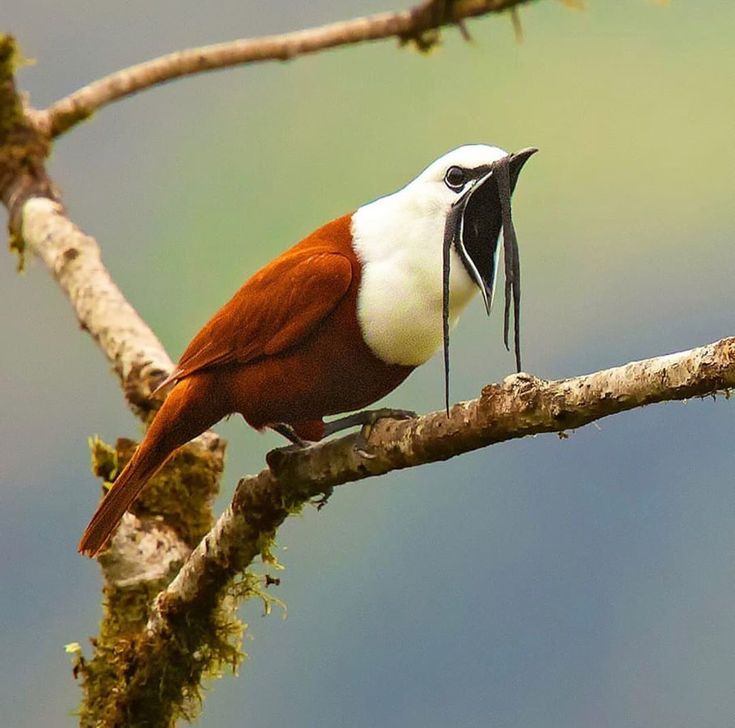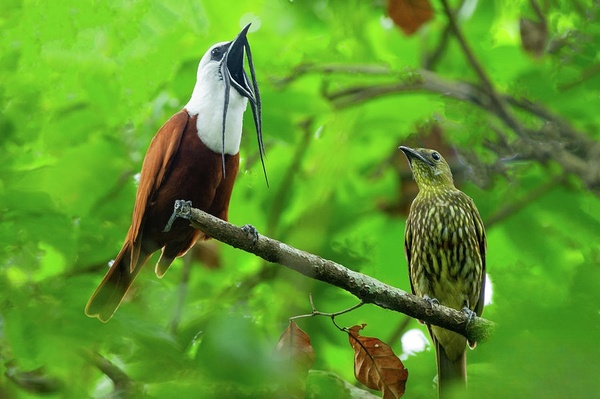The three-wattled bellbird (Procnias tricarunculatus) is one of the most striking and enigmatic birds native to the tropical forests of Central America. Known for its distinctive appearance and unique behavior, this species has captured the interest of ornithologists and bird enthusiasts alike. In this comprehensive guide, we’ll explore everything from its scientific classification and physical characteristics to its conservation status and ecological significance. Whether you’re a birdwatcher or simply curious about the natural world, this article will provide a deep dive into the life of the three-wattled bellbird.

Kingdom: Animalia
Phylum: Chordata
Class: Aves
Order: Passeriformes
Family: Cotingidae
Genus: Procnias
Species: Procnias tricarunculatus
The three-wattled bellbird belongs to the family Cotingidae, which includes some of the most visually remarkable and acoustically impressive birds in the world. It is closely related to other species in the genus Procnias, though its unique features set it apart.
The three-wattled bellbird was first described in 1850 by naturalist Frédéric de Lafresnaye. Since then, researchers have been fascinated by its peculiar behavior and striking morphology. However, despite its remarkable traits, this bird remains somewhat elusive in the wild, making comprehensive studies challenging. Over the years, birdwatchers and scientists have sought to understand its mating rituals, vocalizations, and migratory patterns, contributing to its status as a subject of curiosity in ornithological history.
The three-wattled bellbird is renowned for its dramatic physical features. The males, in particular, stand out due to their white head and throat, contrasting with their rich chestnut-brown body feathers. What makes them truly remarkable are the three long, pendulous black wattles that hang from their bill, making them appear even more otherworldly. These wattles are primarily used in mating displays to attract females and assert dominance among rivals.
Male Physical Traits:
Head and throat: White
Body feathers: Chestnut-brown
Wattles: Three long, black, fleshy extensions from the bill
Body Length: 40-50 cm (15.7-19.7 inches)
Wingspan: Up to 70 cm (27.6 inches)
Weight: 350-400 grams (12.3-14.1 ounces)
The average lifespan of the three-wattled bellbird is estimated to be around 15 years, though in the wild, many birds do not survive past their first few years due to predation and environmental factors.
The three-wattled bellbird is found in Central America, specifically in Costa Rica and Panama. It thrives in tropical rainforests and cloud forests at elevations of 1,000 to 2,000 meters (3,280 to 6,560 feet). These areas provide the dense, rich canopy cover and varied vegetation that this bird prefers for both feeding and breeding.
Preferred Environment:
Tropical rainforests
Cloud forests
High elevations (1,000-2,000 meters)
The three-wattled bellbird is a migratory bird. During the breeding season, males will congregate in their mating territories, where they engage in loud and complex vocalizations to attract females. Once breeding is complete, they move to lower elevations or nearby regions, possibly in search of better food sources or suitable nesting areas.

One of the most defining features of the three-wattled bellbird is its loud, bell-like calls. Males produce distinctive, resonant calls that can travel for miles through dense forest. These vocalizations play an essential role in attracting females and establishing territory. The bellbird’s calls have an unmistakable, otherworldly tone, adding to its reputation as one of the most musically unique birds in the world.
Outside of the mating season, the three-wattled bellbird is relatively solitary. It spends most of its time foraging for fruits, seeds, and insects in the canopy, occasionally foraging in small groups. Its social interactions are primarily focused around breeding activities, with males engaging in competitive vocal displays to secure mates.
Behavioral Patterns:
Solitary outside the breeding season
Engages in competitive vocalizations
Forages in the tree canopy
The three-wattled bellbird is primarily frugivorous, meaning its diet consists mostly of fruits, especially figs, which are abundant in its tropical forest habitat. It also consumes seeds and insects, supplementing its fruit-heavy diet with protein sources. This bird has adapted to its environment by becoming an excellent forager in the forest canopy.
Diet:
Fruits (especially figs)
Seeds
Insects
The bellbird feeds by plucking fruit from trees using its strong beak and occasionally uses its long, flexible tongue to extract insects from crevices in bark. It is an agile and opportunistic feeder, often found moving between trees in search of food.
The three-wattled bellbird has a complex mating ritual that includes its signature vocal displays and wattle-shaking. The males' wattles, which are fleshy extensions from the bill, serve as visual signals to attract females. The breeding season typically begins during the rainy season when resources are plentiful.
Mating Ritual:
Males display their wattles and vocalize loudly
Females select mates based on visual and auditory signals
Once a female has chosen a mate, the pair will construct a nest in the canopy, often in a secluded area where they can safely lay and incubate their eggs. The female is the primary caretaker during the incubation period, while the male continues to display and defend his territory.

The three-wattled bellbird is listed as Near Threatened on the IUCN Red List. This is primarily due to habitat loss and the destruction of its tropical forest environment, which is being cleared for agricultural expansion and logging. The bird’s small range and reliance on specific habitat types make it particularly vulnerable to these threats.
Conservation Status: Near Threatened
Habitat Loss: Deforestation for agriculture and urbanization
Climate Change: Changes in rainfall and temperature affect its forest habitat
Several conservation programs are underway to protect the three-wattled bellbird, including habitat restoration projects and the creation of protected areas in Costa Rica and Panama. Additionally, community-based conservation efforts are being promoted to raise awareness about the importance of preserving the bird’s natural environment.
The three-wattled bellbird plays a significant role in maintaining the health of its tropical forest ecosystem by acting as a seed disperser. By feeding on fruits and subsequently distributing seeds across large areas, the bellbird helps facilitate the regeneration of the forest, promoting biodiversity.
In terms of cultural significance, the bellbird is admired for its majestic calls and vibrant plumage. It has become a symbol of the natural wealth of Central America and is a key species for eco-tourism in the region.
While not a direct source of revenue, the three-wattled bellbird contributes significantly to eco-tourism. Birdwatchers flock to Costa Rica and Panama to observe this elusive species, making it a key draw for nature-based tourism.
Here is a brief comparison of the three-wattled bellbird with its closely related species:
| Species | Scientific Name | Key Differences |
|---|---|---|
| Yellow-billed Cotinga | Carpodectes nitidus | More widely distributed, lacks wattles |
| Bare-necked Umbrellabird | Cephalopterus glabricollis | Larger, with umbrella-like crest instead of wattles |
The three-wattled bellbird (Procnias tricarunculatus) is a fascinating species that captivates with its stunning visual displays, unique vocalizations, and specialized behavior. While this bird faces numerous threats, conservation efforts are helping to ensure its survival. By understanding and protecting these remarkable creatures, we can continue to enjoy their presence in the tropical forests of Central America for generations to come.
animal tags: Cotingidae
We created this article in conjunction with AI technology, then made sure it was fact-checked and edited by a Animals Top editor.